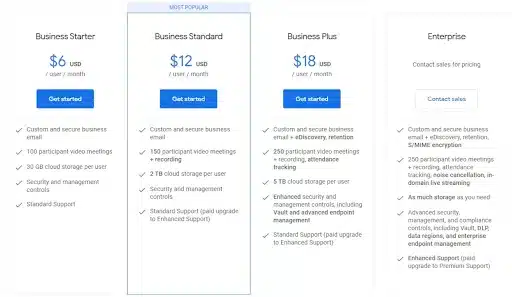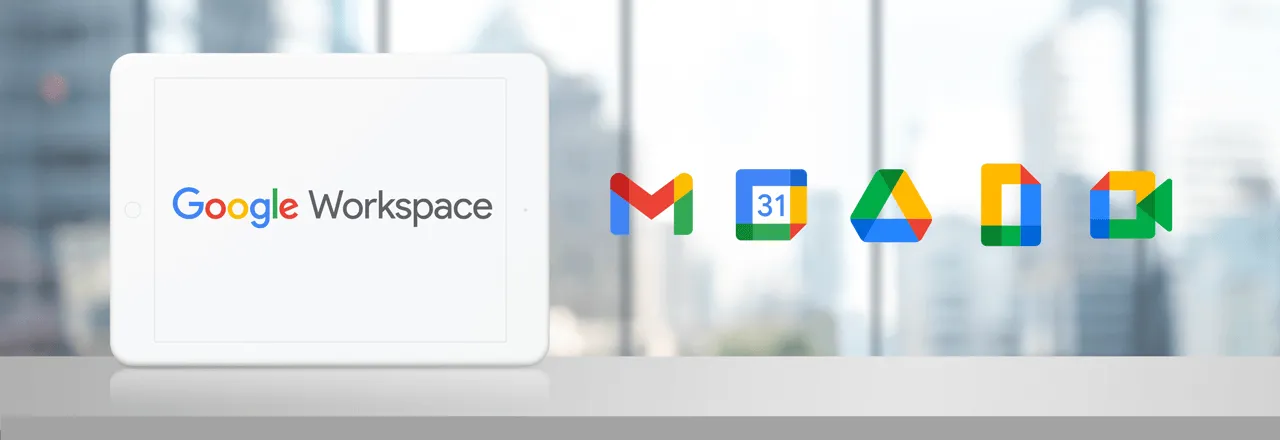Google changed the game by rebranding G Suite to Google Workspace in October 2020, and with it, came new Google Workspace prices. With the addition of new Google Workspace tiers or “editions” to their Workspace pricing model by end of September 2021, users and resellers experienced Google Workspace prices increase. Most recently, as of June 2022, businesses can no longer access its G Suite legacy free edition (Investopedia).
It’s time to look into 2022 and beyond. Get up to speed with “The next generation of MSPs: A 2022 outlook for managed service providers and IT specialists.” Download it now.
All to say, there have been big changes when it comes to Google Workspace prices. To avoid an unnecessarily large bill, all subscribers must take care to update their plans to reflect the realities of the most recent Google Workspace price increase (and subsequent elimination of free legacy apps). If you resell Google Workspace or plan to do so in the future, this is must-know information.
Understanding the changes to Google Workspace prices
Yes, Google is ubiquitous. That doesn’t mean that all the recent changes haven’t been disorienting.
First, Google My Business rebranded as Google Business Profile (Google), but remains just as essential for businesses to set up and optimize. And of course there’s the aforementioned rebrand from G Suite to Google Workspace.
The move from G Suite to Google Workspace includes a new tier system with multiple “editions,” added tools, and new Workspace prices. We want to ensure that you understand what is changing and why before jumping into the specifics of whether the Google Workspace Enterprise price is worth it for your business, or if you’d be better off with Google Workspace Business Plus (we’ll get to it!).
What is Google Workspace?
Google Workspace (former G Suite) is Google’s cloud-based suite of core productivity, communication, and collaboration tools. Google highly prioritizes their security features, as well creating a streamlined user experience. Teams can easily work together in real time, remotely or otherwise, across multiple devices and all in one “workspace”.
It’s not hard to see why businesses and professional organizations across the globe choose to operate within Google Workspace, despite Google Workspace prices increasing.
Every plan, regardless of the Workspace pricing tier or “edition,” comes with the following tools:
- Gmail. Secure business email.
- Drive. Store, share, and access files.
- Meet. Video meetings.
- Calendar. Integrated online calendars.
- Chat. Streamlined messaging and group collaboration.
- Jamboard. Visualize ideas as a team.
- Docs. Powerful word processing.
- Sheets. Collaborative spreadsheets.
- Slides. Beautiful presentations.
- Keep. Capture notes and to-dos.
- Sites. Create sites for teams, projects, or events.
- Forms. Easy to create surveys and forms.
Regardless of Workspace prices, every tier integrates with other products and services from Google.
What are the differences between G Suite and Workspace?
Besides the increase to Google Workspace prices, you might be asking yourself what else has changed in the rebrand from G Suite to Workspace. What is Google Workspace Business Plus, and is it completely different from my old plan? Is the Google Workspace Enterprise price really worth it?
First, what’s staying the same: basically all the core functionality and features that businesses know and love.
Here’s a quick roundup of a few changes that stand out. We will get more into Google Workspace tiers in the following sections.
- Design. Google Workspace has a new aesthetic, with redesigned apps that all share a similar look and feel. As with any visual change, it will take some getting used to—especially since the old icons were so, well, iconic! And at the end of the day, some people will never get used to it (TechCrunch). Seems like some people feel so strongly that if they could pay a special Workspace price for the old designs, they would!
- Increased collaboration. Google made dozens of quality-of-life changes to their apps to make collaboration even easier (Google), which has been a game-changer during the rise of remote teams in the last few years.
- Different verbiage. G Suite’s monthly “plans” have been replaced with “editions,” which introduce new Google Workspace tiers and associated pricing models.
- User caps. Three of the four editions now have a user cap limited to 300 users. That means businesses will have to go Enterprise-level if they want unlimited capabilities.
Google Workspace tiers eliminate the G Suite legacy free edition in 2022
Though the free G Suite apps haven’t been offered to new customers since 2012 (The Register), small businesses that’d benefited from access to the legacy service were automatically migrated to a paid Google Workspace subscription as of June 27th, 2022.
It’s more important than ever to make sure you’re aware of the latest Workspace prices—especially if you were one of the rare, lucky legacy businesses whose last price was “free.”
Either way, everyone is feeling the increase to Google Workspace prices.
Licensing changes and Google Workspace tiers
Most businesses that were using G Suite for years were not on a free legacy subscription. Rather, they were used to paying a small flat fee per user—regardless of how many users they had.
The new Google Workspace tiers changes that.
“In the past, businesses were paying a monthly fee of $6 per employee for G Suite Basic. With the new changes in Google Workspace prices, Google is more than tripling that cost per person per month,” says Jared Eason, Senior Manager of Sales Engineering and Enablement at Vendasta.
The increased Google Workspace prices are due to Google changing its licensing. Instead of having a flat rate for everyone using the product, Google introduced tiers. The top-tiered edition is Enterprise, which includes all businesses with more than 300 employees. But for the Enterprise edition, you need to pay the Google Workspace Enterprise price. And that can be inhibiting for some businesses.
That’s why we’re here to break down Google Workspace tiers and help you decipher what the Google Workspace price increase means for the way your business operates.
Workspace prices and subscription options
It’s important to know what sets Google Workspace tiers apart when it comes to selecting the right edition for your business.
Ultimately, it comes down to operating level and the limitations of usability. An example of this according to Eason is that “in a Google Meet, the number of participants is limited to 100 people. Another limitation is that each user will only have 30GB of data with the lowest edition.”

Regardless of Google Workspace prices, every plan listed above includes the core, cloud-based tools mentioned previously (Gmail, Drive, Meet, Calendar, Docs, Slides, Sheets, Keep, Sites, Forms, Chat, Currents, Jamboard). These collaboration tools are now all available in one spot due to deeper integrations. Unfortunately, if you were to purchase directly from Google, the Enterprise plan is the only plan available for businesses that have more than 300 employees.
Optimizing Workspace pricing for small businesses
The Google Workspace price increase is unavoidable for small businesses but fortunately, there is a way to optimize these changes.
Third-party providers that have a relationship with Google can arrange for discounts as well as negotiating a split of employees between Google Workspace tiers, thus getting the best pricing option and package suited to their small business clients.
“There are additional discounts we can get for our partners. Google will help in that way, but we have to work together to submit individual proposals to Google,” says Eason.
This rule change especially affects businesses with more than 300 employees since Google automatically updated all such subscriptions to the Enterprise tier. For many businesses, the Google Workspace Enterprise price means a substantial jump in costs. Even Google Workspace Business Plus, which is right under Enterprise, might be too inhibitive.
However, businesses with less than 300 employees have avoided being automatically switched to the Enterprise tier. Eason says, “If you have less than 300 users, you can have everyone at the business all under one SKU.”
This means smaller businesses initially had less difficulty navigating these changes. However, there are now multiple editions or Google Workspace tiers to choose from depending on business needs. With each edition ranging from Starter to Enterprise, the Workspace price doubles and then triples.
As the Google Workspace Enterprise price is not listed on the Google site, businesses will have to inform themselves as best they can to navigate through this change.
Google Workspace pricing comparison
Let’s jump into the nitty gritty of what each edition or tier offers and costs so that you can make an informed decision. It’s important to note that Google considers their Workspace prices to be somewhat “flexible” and are willing to work with businesses to find solutions.
As Eason previously noted, engaging with third-party suppliers who have built a relationship with Google might be the best way to negotiate Google Workspace prices and tweak subscriptions to be more tailored to your needs.
Google Workspace Business Starter
Google Workspace Business Starter price: $6USD per month, per user
The Business Starter edition is the most affordable Workspace price, and gives almost any person or business somewhere to begin. It includes the full suite of tools, plus support and other necessities.
The biggest limitation here is the dismal amount of storage space per user, which can become a blocker very quickly.
Limitations:
- Under 300 users
- 100 participant limit on video meetings
- Inability to record video meetings
- 30 GB of storage per user
- No option to upgrade to Enhanced Support
Ideal for:
- Freelancers
- Mom-and-pop shops
- Small businesses that don’t require much storage space
Google Workspace Business Standard
Google Workspace Business Standard price: $12USD per user, per month
The Business Standard edition is the most popular subscription and comes at a reasonable Google Workspace price increase, but still doubles the cost per user from the Starter edition. It ramps up storage capacity exponentially and allows for the ability to record meetings (which is key for certain businesses).
Limitations:
- Under 300 users
- 150 participant limit on video meetings
- 2 TB of storage per user
- Standard support (ability to upgrade) and security controls
Ideal for:
- Small to medium-sized businesses
Google Workspace Business Plus
Google Workspace Business Plus price: $18USD per user, per month
The Business Plus plan is an in-between option for businesses that are big enough to afford it and benefit from the additional functionality, but are still under 300 employees.
It comes with additional benefits such as attendance tracking large meetings, enhanced security including Vault and endpoint management, and more.
Limitations:
- Under 300 users
- 5 TB of storage
- 500 participant limit on video meetings
- Standard support (ability to upgrade)
Ideal for:
- Larger businesses that still under 300 employees
- Organizations where large video conferences are common
Google Workspace Enterprise
Google Workspace Enterprise price: Unavailable; Contact sales
The of the Google Workspace tiers is Enterprise, a powerful, fully decked out solution without user caps or storage limitations.
Additionally, video meetings include perks such as noise cancellation and in-domain live streaming, security is even more advanced, and Enhanced Support is included (with a paid upgrade to Premium support available).
Limitations:
- The Google Workspace Enterprise price is not listed but is likely a limitation depending on the business
Ideal for:
- Businesses over 300 employees
- Organizations who require powerful hybrid or remote solutions
- Industries where the top security features are non-negotiable
How to best navigate the Workspace pricing change
First, sit down with our Workspace price comparisons and decipher whether you fall into the Business or Enterprise category.
After all, the Google Workspace tiers can be viewed as divided into two different groups within Workspace: Business and Enterprise. Within Business, as seen above, there is Business Starter, Business Standard, and Business Plus. What does your particular situation require?
Working with a third-party to optimize Workspace prices
Agencies and MSPs can resell Google Workspace and get their clients an optimized price by working with a third party, as previously emphasized. This will ensure that small business clients get the Workspace pricing and edition best suited for their needs. The third-party provider will have a relationship with Google and can get a better price as well as help you to split up the subscription if needed.
The ability to split up the subscription is another great reason to work with Vendasta. We can request that a certain number of employees get moved to the Enterprise tier, while the remaining employees continue with a less expensive option.
For example, if your client has 400 employees and only requires the first 300 to have an Enterprise subscription, they can negotiate the remaining work under Business Starter.
Google Workspace prices and customer outreach
The implementation strategy will change depending on each client’s needs. Small businesses currently using Google Workspace might need help to figure out a game plan moving forward.
Are your clients working with remote workforces? Do they have over 300 employees? Are they in a sensitive industry such as healthcare and require increased cybersecurity? As these questions are answered, it will become clear which Workspace pricing and subscription options best suit each business.
Ensure that your small business clients are aware of new options like Google Workspace Business Plus and how you can help them navigate Workspace price changes. The following template is a great example of communication that informs the client about the change and also creates a sense of urgency.
Hi everyone!
Perhaps G Suite rebranding to Google Workspace feels like ages ago, or like it was just yesterday. Regardless, as your Account Manager at [XYZ], I’m reaching out to review your current subscription to ensure that you are optimizing the new Google Workspace tiers.
We encourage you to move to new Workspace plans best suited for your future growth. I am happy to discuss what transition path most closely aligns with your current plan to ensure it is a smooth process.
To discuss your accounts transition or the discounts you are eligible for in more detail please let me know or schedule some time here.
Hope to hear from you soon!
Name
Final thoughts: Workspace prices vs. Microsoft 365
Microsoft 365 is the main competitor of Google Workspace. Both platforms provide a collaborative work environment and have loyal users.
The Workspace pricing change has brought up the question of whether it’s worth staying with Google or switching to reselling Microsoft 365 instead. With the update, the Workspace pricing is now comparable to Microsoft 365—though Workspace is still the more affordable of the two.
Google Workspace tiers also offer more diverse plans than Microsoft currently has.
The base plan for Microsoft 365 is $6USD per user, per month. The Microsoft 365 Business Premium plan is set at $22USD per user, per month—yet Google Workspace Business Plus delivers way more capabilities for only $18USD.
Additionally, Microsoft has a separate plan that only includes Apps for business, but no comparable plan to the Google Workspace Enterprise tier.
Even taking into account the Google Workspace price increase, it is still a great option for collaboration and business purposes. By integrating all Workspace products into one dashboard, Google has made its product more user-friendly for businesses of all sizes.
Original author Emily Dyrland, updated in 2022 by Domenica Martinello


